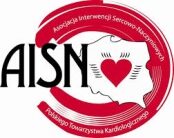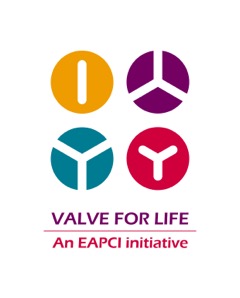Dr Mateusz Barycki
Prezentacja wykładu „Two-year outcomes of double-kissing culotte versus culottetechniques in acute coronary syndrome” w sesji „Bifurcation stenting techniques outcomes”.
Prezentacja przypadków
– „Simple right coronary artery PCI: when a haematoma disrupts the plan” w sesji „Best companion’s case on complications for stable coronary artery disease PCI: episode 1”
– „If all roads led to Rome, which one should I choose – Story of MVD calcified PCI” w sesji „LV support for very high risk PCI of calficied lesions”
Dr Adrian Bednarek
Prezentacje:
– Angio-based vessel fractional flow reserve (vFFR) in bifurcations: prospective OCT and FFR study
– Accuracy of CT-μFR for evaluation of coronary stenoses in patients undergoing TAVI: a pilot study
Dr hab. n. med. Aleksandra Gąsecka van der Pol
Udział w sesji:
– PCI in cardiogenic shock without left ventricular suport
– Mitral abstracts session
– What did we learn from my TAVI complications?
Prezentacja przypadku w sesji „Antithrombotic drugs for acute coronary syndromes in women” Optimal SCAD treatment
Dr Kajetan Grodecki
Prezentacje:
– Deep learning-enabled biopsy of aortic valve from CT angiography to predict outcomes after TAVI
Prof. dr hab. med. Rafał Januszek
Prezentacje:
– Long-Term Outcomes Following DCB Versus Thin-Strut DES for Treatment of ISR in CKD patients
– Carillon System for the right-heart transcatheter MV repair – preliminary single-center results – e-poster
– Mitral valve paravalvular leak closure complicated by severe hemolytic anemia – e-poster
Dr Szymon Jonik
Prezentacje:
– Long-term neurological outcomes after tavr in high-volume cardiovascular care centre.
– Machine-learning pulmonary risk factors affect multivessel coronary revascularization outcomes.
– Redo-transcatheter aortic valve implantation – pilot study from multicentre nationwide registry.
Dr hab. n. med. Michał Hawranek
Udział w sesji:
– Simulation-based Learning – Bailout options and techniques during PCI: stent dislodgement
– Patients with degenerated aortic bioprosthesis – Every case is different
– Advancing the standard of care in PCI with Bioadaptor: from simple to complex
Prezentacje przypadków:
– Cardiac allograft vasculopathy: could restoration of vessel vasomotion be a promising PCI strategy?
– Cardiac Allograft Vasculopathy – An Even Greater Challenge in Paediatric Heart Recipients?
Dr hab. n. med. Marta Kałużna-Oleksy
Prezentacja przypadku „Unintended stent deformation during left main PCI – case presentation” w sesji „Troubleshooting in left main stenting: the role of imaging and physiology”.
Prezentacja przypadku „Left main PCI only with kissing DCBs in young female with systemic lupus erythematosus and cardiogenic shock – case presentation” w sesji DCB in challenging scenarios – Part 2.
Prezentacja przypadku „Can intracoronary imaging be harmful? Risks and Challenges in complex PCI – case presentation” w sesji Chronic coronary syndrome with low ejection fraction and left ventricle support”
Udział w sesji:
– Antithrombotic drugs for acute coronary syndromes in women – With the collaboration of the European Association of Percutaneous Cardiovascular
– Integration of CT and IVUS for treatment of coronary artery disease in daily practice: from planning to drug-eluting therapy
– Integrating CT coronary angiography into your PCI practice.
Dr Karolina Konsek
Prezentacje:
– Prognostic value of angiography-based fractional flow reserve in heart transplant recipients
Dr Maciej Koźlik
Prezentacje:
– Smoker’s paradox – myth or truth? Effects of smoking on long-term prognosis in patients with MINOCA
Prof. dr hab. n. med. Marcin Kurzyna
Prezentacja ustna wykładu „Insights from Strike PE study” w sesji „Key procedural factors in pulmonary embolism treatment with computer-assisted vacuum thrombectomy” w sesji „Key procedural factors in pulmonary embolism treatment with computer-assisted vacuum thrombectomy”.
Techniki kardiologii interwencyjnej stają się standardem leczenia ostrej zatorowości płucnej przebiegającej z zaburzeniami hemodynamicznymi. Trombektomia mechaniczna wykonywana systemami ze wspomaganym komputerowo systemem odsysania skrzeplin zapewnia skuteczną aspirację z minimalną utratą krwi. Potwierdza to przedstawiona na EuroPCR analiza badania STRIKE-PE, które jest jednym z największych prób klinicznych prowadzonych w tej dziedzinie.
Prof. dr hab. n. med. Maciej Lesiak
Producent sesji
– Two-stent techniques for non-left main true bifurcation lesions (sesja typu How should I treat?)
– What did we learn from my TAVI complications? – With the collaboration of the European Association of Percutaneous Cardiovascular Interventions
Udział w sesjach
– Left Main PCI: provisional one stent strategy
– Stent technologies, last evidence in coronary interventions
– IVUS-guided left main bifurcation PCI
– Two-stent techniques for non-left main true bifurcation lesions
– What did we learn from my TAVI complications?
– Left main and complex bifurcation stenting
– Learning live DK crush stenting – in-vitro PCI in a beating heart z prezentajcą ustną My DK crush case: when to consider an upfront two-stent strategy
Dr n. med. Marcin Łubiarz
Dwie prezentacje przypadków:
„Novel approach to optimising coronary angioplasty in complicated cases” w sesji Best companion’s case on coronary complications
Dr Adam Piasecki
Dwie prezentacje przypadków:
1. Prezentacja ustna w sesji „Right ventricule and tricuspid regurgitation: a linked faith”
– Prezentacja pracy pod tytułem „Right ventricle to pulmonary artery coupling as a prognostic factor in tricuspid regurgitation – a systematic review”- W pracy dokonaliśmy przeglądu aktualnych danych dotyczących wartości prognostycznej współczynnika TAPSE/SPAP u pacjentów z niedomykalnością zastawki trójdzielnej. Pomimo uzasadnionych wątpliwości co do echokardiograficznej oceny SPAP u pacjentów z masywną TR, wszystkie dotychczasowe prace pokazują związek TAPSE/SPAP ze śmiertelnością ogólną.
2. Prezentacja ustna w sesji plakatów moderowanych w sesji „Differential strategies to prevent and treat heart failure patients”
– Prezentacja pracy pod tytułem „Eligibility for tricuspid edge-to-edge repair in severe tricuspid regurgitation: a prospective study”
W trakcie pierwszego roku funkcjonowania prospektywnego rejestru pacjentów kwalifikowanych do T-TEER oceniliśmy 140 chorych, z których 71 zostało zakwalifikowanych do interwencji. Najczęstszą przyczyną dyskwalifikacji było zbyt duże zaawansowanie choroby (13.6%) oraz przyczyny anatomiczne (10.0%).
3. Plakaty dotyczące tematyki interwencji w ciężkiej niedomykalności zastawki trójdzielnej
– „Echocardiographic characterization of patients qualified for tricuspid edge-to-edge repair”
– „Efficacy of different systems in transcatheter tricuspid edge-to-edge repair – a comparison of dedicated and non-dedicated devices”
Dr Łukasz Pyka
Prezentacja ustna przypadku „Zero-contrast PCI with intravascular lithotripsy – a viable alternative for kidney failure patients” w sesji „Best companion’s cases on imaging for calcified lesions”.
Dr Piotr Radowski
Prezentacja ustna przypadku „Pacjent z zawałem serca STEMI i spiralną dyssekcją prawej tętnicy wieńcowej, u którego do zlokalizowania prawdziwego światł naczynia wykorzystano obrazowanie IVUS” w sesji „Coronary dissection: when imaging makes the difference”.
Dr Jan Roczniak
Prezentacje:
– Challenging anatomy in multivessel disease in NSTEMI with severely reduced ejection fraction
– Perforation of a heavily-calcified undilatable proximal left anterior descending with stentgraft
Dr Karol Sabatowski
Prezentacje:
– Contrast volume and radiation in OCT vs IVUS guided complex coronary procedures
Dr Karol Sadowski
Prezentacja:
– Impact of sex and vFFR-derived PPG index on QoL and outcomes after PCI
Dr Wojciech Skorupski
Prezentacja ustna wykładu ”Intravascular lithotripsy in the treatment of coronary in-stent restenosis” w sesji „The calcium challenge: stent avoidance and in-stent restenosis treatment”.
IVL is a safe and effective treatment option for in-stent restenosis, demonstrating a high angiographic success rate and a low incidence of procedural complications
Dr n. med. Tomasz Skowerski
Prezentacja ustna wykładu „Renal artery denervation improves myocardial function in patients with heart failure and atrial fibrillation” w sesji „Novel tools and strategies in chronic heart failure.”
Podczas EuroPCR 2025 przedstawiłem wstępne wyniki badania oceniającego nowe zastosowanie denerwacji tętnic nerkowych jako terapii wspomagającej ablację migotania przedsionków u pacjentów z niewydolnością serca. Uzyskane dotąd dane wskazują na potencjalną korzyść tej strategii w poprawie funkcji lewej komory.
Dr n. med. Sylwia Sławek-Szmyt
Dwie prezentacje przypadków:
– Double challenge – complex left main bifurfaction disease
True left main tetrafurcation disease is a highly complex substrate for PCI. The optimal stenting approach in LMCA tetratrifurcation disease is
controversial.
– High-risk pulmonary embolism with resistant shock and disseminated intravascular coagulation
A multidisciplinary approach is necessary to navigate the complex process of selecting the most effective treatments for life-threatening PE. Supportive care should be tailored to the individual patient.
– E-poster
Correlates of coronary microvascular dysfunction in chronic thromboembolic pulmonary hypertension
Dr n. med. Konrad Stępień
Prezentacje
- Reversible perfusion defect in myocardial scintigraphy in coronary artery aneurysm or ectasia
- The reduction of clot lysis time on statins is associated with lipid plaque parameters in OCT in AMI
Dr n. med. Jakub Stępniewski
Prezentacja ustna wykładu „Interactive pulmonary embolism cases” w sesji „A simple low profile solution to the pulmonary embolism problem: EKOS”.
„Dzielenie się doświadczeniem klinicznym w przezcewnikowym leczeniu ostrej zatorowości płucnej zyskuje dziś szczególną wartość – właśnie teraz, gdy stoimy u progu publikacji wyników dużych badań randomizowanych.”
Od prawej: Prof. Robert Ariens Leeds, Wielka Brytania, Prof. Andrew Sharp Dublin, Irlandia, Prof. Stavros Konstantinides Mainz, Niemcy, dr Jakub Stępniewski Kraków, Polska
Dr Tomasz Suchecki
Prezentacja ustna przypadku „Angioplasty of the aneurysmal right coronary artery in the course of IgG4-dependent disease” w sesji „Adressing complex anatomy in STEMI.
„it`s better to think twice than to make a mistake”
Prof. dr hab. n. med. Mariusz Tomaniak
Udział w sesji:
– Road to relief – Effective treatment of refractory angina patients with Shockwave Reducer
– Antithrombotic drugs for acute coronary syndromes in women
Prezentacje:
– Reducer implanting procedure and follow-up
– Personalised treatment strategies for MINOCA in young female patient
Prezentacja przypadku:
– Isolated coronary microvascular disease treated with next-generation coronary sinus reducer w sesji Invasive treatment of refractory angina
Dr Szymon Włodarczak
Prezentacja wykładów
– „Efficacy of CS reducer in refractory angina pectorisassociated with microvascular dysfunction” w sesji „When angina cannot be cured with stents: what are the remaining options”
– „Effectiveness of coronary sinus reducer implantation in routine clinical practice. 12-month outcomes” w sesji „When angina cannot be cured with stents: what are the remaining options”.
Prezentacja przypadków
– „Treatment of refractory angina pectoris associated with coronary microcirculation dysfunction”
– „High-risk PCI facilitated with levosimendan and mechanicalleft ventricular support”


